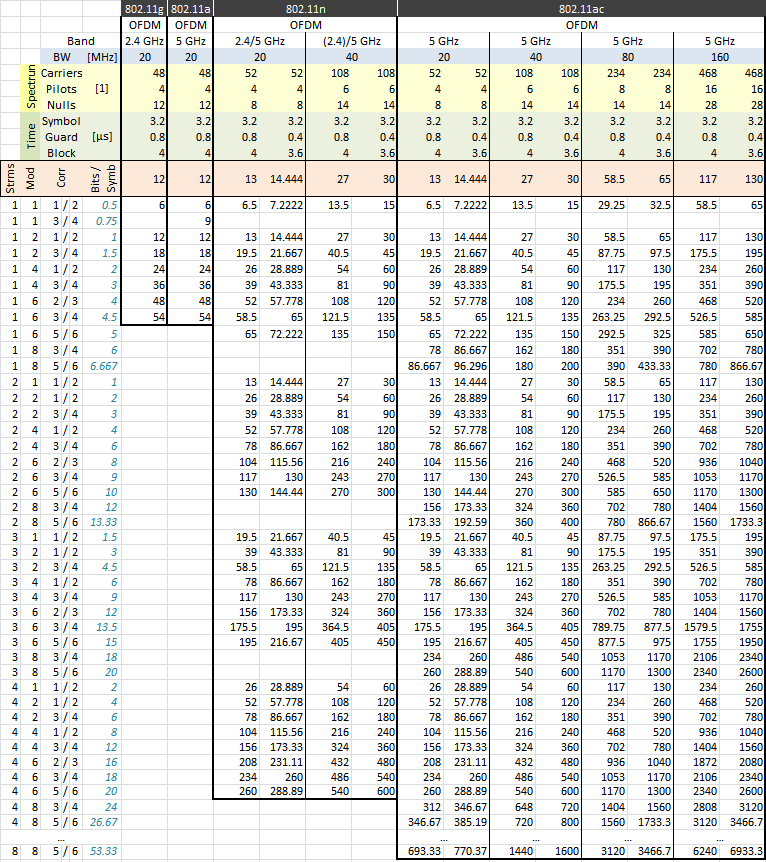MIMO
MIMO
Multiple-input Multiple-Output (MIMO) is a communication method for wireless transmission where both
- transmitter and receiver use multiple antennas.
The use of multiple antennas at both sides of the link creates a multi-path propagation environment
- between transmitter and receiver that can be used to significantly improve the system throughput.
The origin of the improvement can be intuitively understood by thinking of the multi-path propagation
- MIMO environment as the equivalent of several separate paths between transmitter and receiver.
Every one of these paths (or “streams”) can be independently used for data transmission with each
- employing the full bandwidth available to the system. This is referred to as spatial multiplexing.
The higher the number of antennas, the higher the multiplexing gain.
In addition, MIMO enables other advanced techniques like beamforming and MU-MIMO.
- The higher the number of antennas, the more efficient these techniques become.
MU-MIMO
Multi-User MIMO (MU-MIMO) provides an alternative use of the spatial multiplexing that is provided by MIMO.
- MIMO enables the transmission of multiple independent streams between a transmitter and a receiver with
- multiple antennas. However, without MU-MIMO, the spatial multiplexing gain is limited by the number
- of antennas at the client devices (typically one or two), leaving a lot of spatial diversity unused.
MU-MIMO extends the MIMO concept to the case with one transmitter and multiple receivers (Downlink MU-MIMO)
- or to the case with one receiver and multiple transmitters (Uplink MU-MIMO), allowing the full use of the spatial
- diversity provided by the channel. Instead of being able to transmit to a single client, an MU-MIMO capable
- system can transmit to several clients simultaneously, using the full bandwidth of each link.
802.11a/g
Proprietary MIMO technology can be found in some Wireless-G devices.
- However, both the access point and the adapter must support the same technology.
These proprietary MIMO modes are not standardized between vendors..
Most high throughput modes (including some branded as MIMO) do not use MIMO tech.
Proprietary vendor specific MIMO modes, by manufacturer
Airgo True MIMO (Gen1, AGN100) - max. PHY rate of 108Mbps (2x2/2x3),
- two spatial streams
Airgo True MIMO (Gen3, AGN300) - max. PHY rate of 240Mbps (2x2/2x3) • PCWordl,
- two spatial streams, channel bonding
Atheros VLocity (AR5513) - 108Mbps (two Tx/Rx chains, single spatial stream
- [not really 'True' MIMO], channel bonding [Super G / Super AG])
- 11 client adapters using AR5513, 4Empty strings are not accepted. embedded systems using AR5513
Additional (non-MIMO) proprietary vendor specific modes, by manufacturer
Atheros Super G / Super AG - 108Mbps max. signalling rate (w/ channel bonding)
Broadcom Afterburner (125HSM) - 125Mbps theoretical max. signalling rate
- Linksys SpeedBooster
Ralink MIMO XR - 108Mbps (while branded MIMO, RT2661 only supports multiple receive chains..)
- Linksys RangeBooster
- Belkin Wireless G Plus MIMO
Intersil Nitro - claimed ~140Mbps throughput (per Wikipedia)
802.11n
MIMO is a part of the 802.11n specification. Different notations may be used
- to describe the MIMO capabilities of a given device.
TxR:S
- T: Number of transmit radio chains
- R: Number of receive radio chains
- S: Number of spatial data streams
- 1x1:1 - 150Mbps transmitting and receiving
- 1x2:2 - 150Mbps transmitting, 300Mbps receiving
- 2x2:2 - 300Mbps transmitting and receiving
- 2x3:2 - 300Mbps transmitting and receiving
- 3x3:2 - 300Mbps transmitting and receiving
- 3x3:3 - 450Mbps transmitting and receiving
May also be described as xTyR where x is the number of transmit radio chains and y is the number
- of receive radio chains. This notation neglects the number of spatial data streams.
- 1T1R SISO - 150Mbps transmitting and receiving (single input single output)
- 1T2R MISO - 150Mbps transmitting, 300Mbps receiving (multiple input single output)
- 2T2R MIMO - 300Mbps transmitting and receiving (multiple input multiple output)
- 2T3R MIMO - Usually 300Mbps transmitting and receiving (multiple input multiple output)
- 3T3R MIMO - 300Mbps or 450Mbps transmitting and receiving depending on the number
- of spatial streams (multiple input multiple output)
What is a "Stream" anyway? (how 802.11n works)
